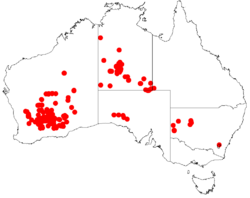Biology:Acacia jennerae
| Cooavittra wattle | |
|---|---|
| Scientific classification | |
| Kingdom: | Plantae |
| Clade: | Tracheophytes |
| Clade: | Angiosperms |
| Clade: | Eudicots |
| Clade: | Rosids |
| Order: | Fabales |
| Family: | Fabaceae |
| Subfamily: | Caesalpinioideae |
| Clade: | Mimosoid clade |
| Genus: | Acacia |
| Species: | A. jennerae
|
| Binomial name | |
| Acacia jennerae Maiden
| |

| |
| Occurrence data from AVH | |
Acacia jennerae (common name Coonavittra wattle)[1][2] is a shrub or tree belonging to the genus Acacia and the subgenus Phyllodineae that is endemic to arid parts of central Australia .
Description
The tree typically grows to a height of 1 to 6 metres (3.3 to 19.7 ft)[3] an has an erect to spreading habit. It has smooth or finely fissured bark with a tan to reddish brown coloured and glabrous branchlets that are angled or flattened towards the apices. Like most species of Acacia it has phyllodes rather than true leaves. The evergreen and glabrous narrowly elliptic to oblanceolate shaped phyllodes are straight to slightly curved with a length of 5 to 15 cm (2.0 to 5.9 in) and a width of 5 to 25 mm (0.20 to 0.98 in)and have a prominent midvein.[1] It produces yellow flowers from January to August.[3]
Taxonomy
The species was first formally described by the botanist Joseph Maiden as part of A.J.Ewart and O.B. Davies 1917 work Acacias of the Northern Territory as published in The Flora of the Northern Territory. It was reclassified as Racosperma jennerae by Leslie Pedley in 2003 then transferred back to genus Acacia in 2006.[4] The specific epithet honours Amelia Maud Jenner who was once the librarian at the Royal Botanic Gardens, Sydney.[1]
Distribution
It is native to the Northern Territory and now found in an area in the Wheatbelt and Goldfields-Esperance regions of Western Australia.[3] It is also native to New South Wales and South Australia,[1] and to far south-western Queensland.[5]
See also
References
- ↑ 1.0 1.1 1.2 1.3 "Acacia jennerae: PlantNET - FloraOnline". http://plantnet.rbgsyd.nsw.gov.au/cgi-bin/NSWfl.pl?page=nswfl&lvl=sp&name=Acacia~jennerae.
- ↑ "Fact sheet for Acacia jennerae". http://www.flora.sa.gov.au/cgi-bin/speciesfacts_display.cgi?form=speciesfacts&name=Acacia_jennerae.
- ↑ 3.0 3.1 3.2 "Acacia jennerae". FloraBase. Western Australian Government Department of Parks and Wildlife. https://florabase.dpaw.wa.gov.au/browse/profile/3395.
- ↑ "Acacia jennerae Maiden". Atlas of Living Australia. Global Biodiversity Information Facility. https://bie.ala.org.au/species/https://id.biodiversity.org.au/node/apni/2916449#names. Retrieved 23 June 2020.
- ↑ Maslin, B.R. (2020). "Acacia jennerae". Flora of Australia. Australian Biological Resources Study, Department of Agriculture, Water and the Environment, Canberra. https://profiles.ala.org.au/opus/foa/profile/Acacia%20jennerae. Retrieved 29 February 2020.
Wikidata ☰ Q15287454 entry
 |

